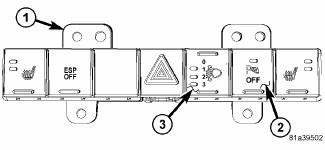Dodge Journey: Switch, headlamp leveling, export
DESCRIPTION

Fig. 45: Identifying Park Assist Switch
The headlamp leveling switch (3) is used only on vehicles manufactured for certain export markets where the headlamp leveling system is required. The headlamp leveling switch is integral to the switch pod (1), which is secured to the instrument panel center bezel just above the heater and air conditioner controls. A stencil-like International Control and Display Symbol icon for Headlamp Levelling Control identifies the headlamp leveling switch button.
The switch push button is also marked with the numbers 0 , 1 , 2 , and 3 , which indicates each of the four headlamp leveling positions. Each higher number represents a lower aiming position of the headlamp beam relative to the road surface. The headlamp leveling switch button has panel lamps dimmer controlled illumination for night visibility. The switch button also features a jewel like Light Emitting Diode (LED) indicator adjacent to the numbers 1 , 2 , and 3 . The appropriate LED is illuminated when that headlamp position is currently selected. The momentary switch push button is operated by depressing, then releasing the top or bottom of the button in a rocker-like manner to enable the selection of a sequentially higher or lower position with each button press.
All of the circuitry and components of the headlamp leveling switch are contained within the molded black plastic instrument panel switch pod housing. A single connector receptacle is integral to the back of the switch pod housing. The switch pod is connected to the vehicle electrical system through a dedicated take out and connector of the instrument panel wire harness.
The headlamp leveling switch cannot be adjusted or repaired and, if ineffective or damaged, the entire instrument panel switch pod unit must be replaced.
OPERATION
The status of the headlamp leveling switch is continually monitored by the circuitry within the instrument panel switch pod. The switch pod receives battery voltage at all times on a fused battery feed circuit, and a path to ground at all times through the instrument panel wire harness. The only other inputs to and outputs from the switch pod consist of electronic communication with the ElectroMechanical Instrument Cluster (EMIC) (also known as the Cab Compartment Node/CCN) over the single wire Local Interface Network (LIN) data bus.
Whenever the headlamp leveling switch push button is depressed the switch pod circuitry sends an electronic select status up or select status down message input to the EMIC over the LIN data bus. The EMIC then sends the appropriate electronic select request up or select request down message to the TIPM over the Controller Area Network (CAN) data bus.
The TIPM responds to these messages by providing a voltage output to the headlamp leveling motors through high side drivers on the headlamp leveling motor right and left signal circuits to move the headlamp reflectors to the selected position based upon the voltage input received from the TIPM. The TIPM also sends the appropriate electronic messages back to the EMIC and the EMIC relays the messages back to the switch pod to control the illumination of the 1 , 2 or 3 Light Emitting Diode (LED) selected position indicator in the leveling switch button. The EMIC and TIPM logic will only allow the headlamp leveling system to operate while the ignition switch is in the ON position and the exterior lighting is turned ON.
The hard wired circuits for the instrument panel switch pod may be diagnosed using conventional diagnostic tools and procedures. However, conventional diagnostic methods will not prove conclusive in the diagnosis of the headlamp leveling switch or the electronic controls and communication between other modules and devices that provide some features of the headlamp leveling system.
The most reliable, efficient, and accurate means to diagnose the headlamp leveling switch or the electronic controls and communication related to headlamp leveling system operation requires the use of a diagnostic scan tool. Refer to the appropriate diagnostic information.
 Switch, hazard warning
Switch, hazard warning
DESCRIPTION
Fig. 44: Instrument Panel Switch Pod
The hazard switch (3) is integral to the instrument panel switch pod (1),
which is secured to the instrument
panel center bezel just above the h ...
See also:
Without intermediate shaft
NOTE: The inner tripod joints are designed with a retention feature
that prevents the
tripod rollers from coming out of the inner joint housing up to a specific
load. If
this feature is o ...
Accumulator
DESCRIPTION
Fig. 238: Identifying Underdrive & Overdrive Accumulators
- RETURN SPRING
- UNDERDRIVE CLUTCH ACCUMULATOR
- SEAL RING (2)
- OVERDRIVE CLUTCH ACCUMULATOR
The 41TE underd ...
Standard procedure
BRAKE ROTOR MACHINING
NOTE: Refacing the rotor is not required each time the brake pads are
replaced, only
when the need is foreseen.
Any servicing of the rotor requires extreme care to ma ...

